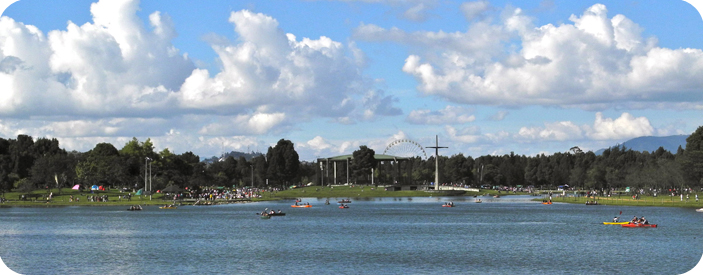Choosing People over Cars to Build a Better City
 Tuesday, April 5, 2011 at 11:24PM
Tuesday, April 5, 2011 at 11:24PM Post by John Michael
 Parque Simon Bolivar, Bogota, Colombia
Parque Simon Bolivar, Bogota, Colombia
In my country, we are just learning that sidewalks are relatives of parks – not passing lanes for cars.
Over the past 80 years we have been building cities for cars much more than for people. If only children had as much public space as cars, most cities in the world would become marvelous.
Enrique Peñalosa, Mayor of Bogotá, 1998-2000
On my second day in Bogotá, I was seated in a sidewalk café with two friends, and, as I was about to take a sip of aromatica, which was the local version of herbal tea, in this case containing stalks of fresh lemongrass and peppermint, I sneezed three times in rapid succession. “Welcome to Bogotá,” one of my friends responded in an almost sardonic voice. A few days later, when I was walking with another friend along the Carrera Septima, one of Bogotá’s main avenues, I gestured at the clouds of thick and dark-grey diesel exhaust in which we were surrounded, and noted that Bogotá had the most terribly polluted air of any city that I had ever lived in. “Oh,” she replied in a conciliatory tone, “but it’s not half as bad as it used to be.” And the truth is that Bogotá’s air was once much worse than it is today.
The current reduction in harmful aerial contamination in Bogotá was largely due to a series of local government initiatives aimed at improving the overall health of the city’s inhabitants. Chief among these initiatives was the Transmilenio, a system of dedicated bus lanes on three of Bogotá’s major avenues that “moves 750,000 passengers per weekday.” Since its creation, “traffic along its route[s] during the morning rush hour is moving 14% faster, and the rush hour itself begins 11 minutes later.” Additional initiatives meant to improve the quality of life for Bogotanos included the creation of parks, the refurbishment of existing public spaces, the planting of trees, and the building of sidewalks, bike paths, and greenways. The mind behind this citywide transformation was Enrique Peñalosa, who was the mayor of Bogotá from 1998 to 2000, and who dedicated his term to bettering the lives of his fellow citizens through improving the city’s infrastructure.
Since finishing his term as mayor, Peñalosa has traveled the globe, advising city officials worldwide in ways to improve their urban centers. When he speaks, he reveals an inspiring and hopeful vision of how our cities can become better places for their citizens. With words like, “Public space is for living, doing business, kissing, and playing. Its value can’t be measured with economics or mathematics; it must be felt with the soul,” and, “God made us walking animals – pedestrians. As a fish needs to swim, a bird to fly, a deer to run, we need to walk, not in order to survive, but to be happy,” Peñalosa imparts a human-centered philosophy of city-planning, with this last quote particularly revealing his stance that cities should be built for people, and not for cars.
But, as evidenced by the smog that still plagues Bogotá’s air, the transformation of this city is far from over. While visionaries like Peñalosa are important to begin change, the vision that informs that change has to become a common dream, something that all, or if not all, then at least a large number of Bogotanos are willing to work towards achieving. And the implementation of a vision such as Peñalosa’s will inevitably face obstacles from the entrenched powers of the past, like the disgruntled conventional bus owners, who, fearing a further reduction in their own businesses, in 2006 were opposed to an expansion of the Transmilenio project. Inciting change, as difficult as it may first appear to those who are engaged in it, can seem to have been the easy part in retrospect when compared to the effort that it takes to truly integrate a vision of change into a culture, and then to slowly and carefully make that vision a viable and sustainable reality.
We had to build a city not for businesses or automobiles, but for children and thus for people. Instead of building highways, we restricted car use. … We invested in high-quality sidewalks, pedestrian streets, parks, bicycle paths, libraries; we got rid of thousands of cluttering commercial signs and planted trees. … All our everyday efforts have one objective: Happiness.
Posted by John Michael
 Bogotá,
Bogotá,  City Planning in
City Planning in  Environment
Environment 

Reader Comments